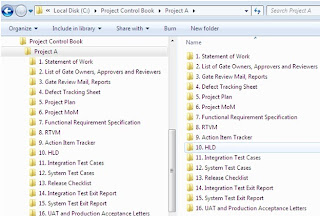I have always been asked by many people what is the best way to inculcate a good review process around a project to stenghthen the delivery process. This caused me to think and implement below Gate Review Process to my projects. Trust me, this process has resulted realy good outputs/results if followed religiously.
Problem Statement
Most of the project delivery goes through the critical path at the time of final delivery, and one of the reasons is observed that during the whole SDLC we are not reviewing the completeness of deliverables. This results in not identifying the risks at the right time and issues/rework at later stages.
Proposal
Gate Process: In a SDLC process, the whole delivery is divided into several phases. Each of the phases has pre-defined entry and exit criteria. For every phase, there is list of stakeholders who needs to review the progress of the last phase and decide to move to the next phase.
Rules and Procedure:
1. A Gate need to be approved before starting on next Gate
2. Gate Owner is responsible for arranging the Gate review meeting. Along with meeting request, he should send the list of deliverables for review
3. All the Gate reviewers must give their approvals/review comments either before (via email) or during the scheduled/planned meeting.
4. Gate Approver will take the final decision to approve/reject the Gate or passing it with Concession(with list of action items along with their closure dates)
5. A Gate can be approved with concessions (List of Pending Action Items with defined closure dates) but the next Gate can’t be approved, unless the concessions taken in previous Gate are addressed.
6. Gate Owner will publish the Gate Report on Close of Gate Meeting.
7. Every project plan should have these gates defined with planned dates and efforts.
8. In-case the Onshore PM/Offshore PM/ Development Head needs any tailoring in above process, due to project requirements, the concession for the same needs to be taken in G0 or G1 phase.
Gate
|
Gate Name
|
Owner
|
List of Deliverables
|
Gate Reviewers Mandatory (in Green), Approver(in Red) and Stakeholder (Blue)
|
G0
|
Project Sign Off
|
onshore PM
|
1. SOW/Scope Statement
2. Project Charter
3. Stakeholder Register
4. Project Site Locations
|
Onshore PM, Project Sponsor,
Development Head, Offshore PM
|
G1
|
Project Kick Off
|
Offshore PM
|
1a. WBS/Task List
1b. Project Plan/Schedule
2. Signed Off FRS
3. RTVM
4. Team Allocation
5. Risk Assessment Meeting
6. Project Management Plan
7. Dev/Beta/Staging Refresh from Prod
8. Project Kick-Off Meeting (Full Project Team)
|
Development Head, Offshore PM, Onshore PM,Technical Lead, DBA
|
G2
|
Design Complete
|
Offshore PM
|
1. RTVM
2a. Approved HLD/LLD
2b. Process Flow Diagram(s)
2c. Data Flow Diagram(s)
4. Issue & Risk Register Updates
5. Test Plan
6. Design Review Meeting
|
Onshore PM, Offshore PM, Development Head, Technical Leads, DBA, Client
|
G3a
|
Coding Complete
|
Offshore PM
|
1. Updated HLD/TDD
2. Updated Project Plan/Schedule
3. Build Promoted to Beta
4. IT and System Test Scenarios and Test Cases Ready
5. Updated RTVM
6. Issue & Risk Register Updates
7. Code Review Meeting
|
Offshore PM, Development Head, Onshore PM,Technical Lead, DBA
|
G3b
|
Integration(Staging) Complete
|
Offshore PM
|
1. Updated Project Plan/Schedule
2. IT tested Build
3. IT Exit Report/Completed Test Cases(Dev team)
4. Updated System Test Cases
5. Implementation Review
6. Defect Tracking Sheet
7. Updated RTVM
8. Release Checklist(Dev team)
9. Issue & Risk Register Updates
|
Delivery Head, Offshore PM, ONSHORE PM, Technical Lead, DBA
|
G4
|
System Test Complete
|
Offshore PM
|
1. Updated Project Plan/Schedule
2. System Test Exit Report/Completed Test Cases
3. Updated Defect Tracking Sheet
4. Updated RTVM
5. Implementation Plan– Draft
6. Build Promoted to Staging
7. Issue & Risk Register Updates
8. UAT Preview
|
Delivery Head, Offshore PM, Onshore PM, Technical Lead, DBA
|
G5a
|
UAT Complete
|
Onshore PM
|
1. Updated Project Plan
2. UAT Exit Report
3. Updated Defect Tracking Sheet
4. Updated RTVM
5. Implementation Plan– Final
6. Final Build Promoted to Beta/Staging
7. Signed Release Acceptance Document
8. Updated Issue & Risk Register
9. Go/No-Go Meeting (Full Project Team)
|
Onshore PM, Client, Development Head, Offshore PM, Technical Lead, DBA, Project Sponsor
|
G5b
|
GOLIVE
|
Onshore PM
|
1. Customer Issue Tracker
2. Updated Defect Tracking Sheet
3. Updated Issue & Risk Register
4. Build Deployed to Production
5. Updated RFC Record
6. Project Close-Out
|
Onshore PM, Offshore PM, Development Head,
Technical Lead, DBA
|
Project Control Book
To store and control the outcome documents of above given process and gates, a Project Control Book should be created as shared repository which will reside inside every project folder and will store the deliverables of every gate. The idea is to have the updated latest version of any deliverable available at a single location at any given point of time.

